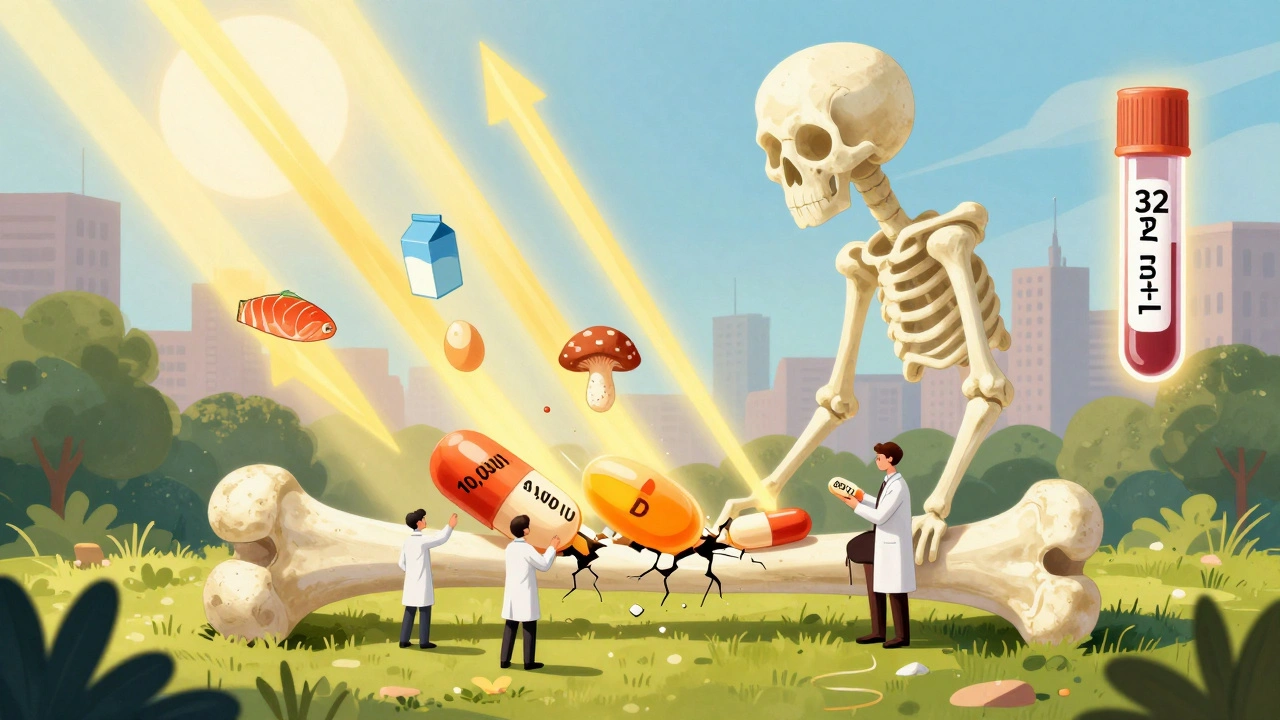Ovulation tests have often been associated with baby-making, but that's not their only trick. Imagine you've got that pesky Premenstrual Syndrome (PMS) knocking at your door like clockwork every month, making everything just a tad more challenging. Well, what if I told you ovulation tests might help keep PMS in check? Sounds good, right?
So, what's the deal with ovulation? It's all about that egg springing free from your ovary, usually smack in the middle of your menstrual cycle. And here's where it gets interesting: by using an ovulation test, you can predict when this little event happens. This is handy, because understanding your cycle better can help predict when your PMS symptoms might show up.
- Understanding Ovulation and PMS
- The Science Behind Ovulation Tests
- Predicting PMS with Ovulation Tests
- Benefits Beyond Conception
- Practical Tips for Using Ovulation Tests
Understanding Ovulation and PMS
Ever wondered how that tiny egg, which none of us can see with the naked eye, has such a huge impact on how we feel? Well, it's all about understanding ovulation and its link to PMS. Ovulation is that time in the monthly cycle when an egg is released from an ovary. This usually happens around day 14 if you have a regular 28-day cycle. But let's be real, not everyone's cycle runs like clockwork, right?
The release of an egg causes hormone levels to dance around like they're on stage at a rock concert, and this hormonal chaos is particularly significant for PMS symptoms. Levels of estrogen and progesterone rise and fall during this time, and if you've ever felt like you're on a roller coaster of mood swings, bloating, or headaches, you can thank these hormones for that.
The Ovulation-PMS Connection
The interesting bit is how ovulation can be a key player in managing PMS. By predicting when ovulation happens, you can better anticipate PMS timing. It's like knowing a storm is coming, so you grab your umbrella—same concept, but swap the umbrella for some symptom relief strategies.
| Hormone | Role in Ovulation | Impact on PMS |
|---|---|---|
| Estrogen | Thickens uterine lining | Can lead to mood swings |
| Progesterone | Prepares uterus for pregnancy | Causes bloating and headaches |
So, next time some random cravings or a sudden urge to cry over a cute puppy in a commercial creeps up, you might just have a clue who the culprits are and how your body reached that point.
The Science Behind Ovulation Tests
You might wonder, how does an ovulation test figure out when that notorious egg is released? It's not crystal ball magic—it's all about hormones! Specifically, it tracks a hormone called luteinizing hormone (LH) that surges right before ovulation.
How Do Ovulation Tests Detect LH?
Essentially, when you pee on that ovulation stick, the test is hunting for a surge in luteinizing hormone in your urine. This hormone jumps like crazy just before an egg pops out of your ovary, usually happening about 24 to 36 hours before ovulation. So, a positive ovulation test is like your body's way of ringing the bell to say, 'Egg release is coming!'
Now, you might find some kits with digital readers and others with lines. The digital ones will tell you straight up, but with the line tests, you'll need to compare the test line with the control line. If the test line is just as dark or darker than the control line, congratulations, you've hit the jackpot of ovulation prediction!
The Role of Ovulation Tests in Conception and PMS
Here's a cool fact: some ovulation tests can detect estrogen too. This hormone increases before the LH surge, providing an even clearer window into your monthly cycle's hormonal fluctuations. Why does this matter for PMS? Knowing when hormones are playing tag within your body can help you anticipate and manage PMS symptoms better.
Thinking about the science like this: ovulation tests are your handy guidebook to the menstrual cycle's ebbs and flows. By predicting ovulation, they allow you to mentally and physically prepare for any possible PMS-related disruptions. It's like getting a head start on those mood swings or cramps that could pop up.
Key Stats to Know
| Aspect | Details |
|---|---|
| LH Surge Timing | 24-36 hours before ovulation |
| Test Accuracy | Typically over 99% if used correctly |
So, the next time you're standing in the pharmacy aisle wondering which box to grab, you'll know exactly what's happening behind the scenes. Armed with this knowledge, you're not just buying a test; you're buying control over understanding your body's intricate timetable.

Predicting PMS with Ovulation Tests
OK, let’s paint a picture: you’re tired of surprise PMS symptoms sneaking up on you, right? Here’s where ovulation tests can swoop in to save your day. These nifty tools tell you when you’re ovulating, which is key to unraveling the mystery of your premenstrual syndrome timing.
First up, here's how it works. Ovulation tests measure the surge of luteinizing hormone (LH) in your urine—this surge usually means you’re about to ovulate within the next 12-36 hours. And because PMS typically begins after ovulation, knowing your ovulation date helps you predict when PMS is likely to start. Pretty cool, huh?
Why Timing Matters
By pinpointing your ovulation, you can keep an eye on when those PMS symptoms could kick in. Suppose you regularly note that your mood swings, bloating, or cramps start around day 18 of your cycle. Knowing your ovulation day helps you nail down exactly when to expect them, which is a game-changer for planning activities and managing symptoms.
Helpful Tips and Tricks
- Track regularly: Start using ovulation tests several months in a row to get a solid pattern of your cycle.
- Note symptoms: Jot down any PMS symptoms in a journal and the days they appear.
- Stay consistent: Take the test at the same time each day for accurate results.
Remember, everyone’s cycle is unique. This isn’t a one-size-fits-all. But with a bit of patience and a dash of curiosity, ovulation tests can help you stay ahead of PMS surprises. It’s all about taking control where you can!
Benefits Beyond Conception
When most people think about ovulation tests, they immediately associate them with planning a family. But these little sticks offer much more—it turns out they can be a secret weapon in managing PMS!
First off, knowing exactly when you're ovulating helps nail down when your PMS symptoms occur. We all know that menacing symptoms can sneak up on you like an unwanted surprise. But you can use this info not just to brace yourself, but to plan proactively.
Tracking for Better Symptom Management
Once you know your ovulation date, you can anticipate when the PMS party is about to start. This helps in scheduling activities and managing workloads when you're less likely to feel like your usual self. It's not just about feeling better—it's about planning your social life, your job, and everything in between with clarity.
Improving Lifestyle and Diet Choices
Arming yourself with this knowledge means you can make lifestyle adjustments ahead of time. This clarity can guide diet choices to curb bloating or fatigue. Because let's be real, no one wants to deal with the double whammy of discomfort and unplanned chaos.
- Consider reducing caffeine and sugar intake when PMS approaches, as they often exacerbate symptoms.
- Increase magnesium-rich foods like spinach and dark chocolate—they're known to help soothe cramps.
Mental Health Benefits
Emotions can run high during PMS, sometimes impacting mental well-being. An ovulation test can offer mental relief, letting you know that those mood swings are temporary and hormonal. This understanding reduces stress and can even improve relationships since everyone's on the same page. Who knew a simple test could turn into a relationship savior?

Practical Tips for Using Ovulation Tests
If you've decided to dive into the world of ovulation tests to get ahead of your PMS game, congrats! You're about to learn how to harness some neat tricks. Let’s break down how you can make the most out of these little strips of magic.
1. Know When to Start Testing
Timing is everything. You generally want to start testing a few days before you expect to ovulate. If your cycle is, say, 28 days, then you might begin on day 10. The key here is consistency—try to test at the same time every day for the most accurate results.
2. Follow Instructions to a T
Each test comes with its own brand of instructions, so follow those like your favorite recipe. Whether it’s pee-on-a-stick or dipping it in a cup, how you use it matters for the results.
3. Track Your Results
Recording your results somewhere handy, like a journal or a period-tracking app, helps. It can reveal patterns after a few months, giving you a heads-up on your PMS symptoms before they show.
4. Morning Routine
It can be tempting to test whenever, but using your first morning urine might give a stronger signal because it's more concentrated. This is especially important when pinpointing low hormone surges.
5. Keep an Eye on Symptoms
Besides the test results, tune into your body. Are you feeling a bit crampy or have tender breasts? Noticing these alongside test kits will give a fuller picture of your cycle.
6. The Limitations
Remember, these tests aren't foolproof for diagnosing all parts of your menstrual cycle accurately. Sometimes stress, illness, or any change in routine can mess with your ovulation pattern, throwing off the test results.
Ovulation tests can lend you a hand in tackling premenstrual syndrome with a bit more grace and predictability. As with everything, practice makes perfect. Hopefully, these tips bring you some peace of mind and more control over pesky PMS surprises!







Robert Ortega
February 18, 2025 AT 13:01Thanks for breaking down how ovulation tests can be a useful tool beyond just trying to conceive. It’s cool to see the hormonal side of things laid out in plain language, especially for folks who might feel overwhelmed by the science.
Elizabeth Nisbet
February 20, 2025 AT 06:41Really appreciate the practical tips you shared! I’ve started tracking my LH surge for a few cycles now, and it’s helped me plan workouts and social events when I know my PMS is likely to hit.
Sydney Tammarine
February 22, 2025 AT 00:21Obsessed with the idea that a simple stick can become my personal crystal ball for PMS! 🌟 Who knew something marketed for baby‑making could double as a mood‑swing savior? The science sounds legit, but the feeling of being one step ahead? Absolutely divine. 😌
josue rosa
February 23, 2025 AT 18:01From a physiological perspective, the luteinizing hormone surge represents a pivotal endocrine event that precipitates ovulatory rupture, thereby initiating the luteal phase wherein progesterone exerts its thermogenic and myometrial effects. By quantifying this surge through immunochromatographic assays, ovulation kits provide a temporal marker that can be mapped onto the subsequent probabilistic window for premenstrual symptom manifestation. The temporal fidelity afforded by such kits is contingent upon assay sensitivity, which typically exceeds 99 % when the user adheres to manufacturer‑specified timing protocols and minimizes confounding variables such as diurnal hormone fluctuation. Moreover, the integration of estrogen detection strips augments the pre‑LH plateau data set, allowing for a more nuanced longitudinal model of follicular development. When constructing a predictive algorithm for PMS onset, one must incorporate the biphasic nature of progesterone secretion, which peaks approximately 5–7 days post‑ovulation and correlates with the intensification of somatic symptoms such as bloating, breast tenderness, and affective lability. Empirical studies have demonstrated that individuals who employ ovulation testing as part of a broader symptom‑tracking regimen report a statistically significant reduction in perceived symptom severity, likely mediated by anticipatory coping strategies. It is also noteworthy that the psychological component of agency-knowing when the hormonal cascade will unfold-may itself modulate the hypothalamic‑pituitary‑adrenal axis, thereby attenuating stress‑induced exacerbation of PMS. Consequently, the utility of ovulation tests transcends mere conception planning; they function as a real‑time biofeedback mechanism. In clinical practice, this can be leveraged to tailor interventions such as timed dietary modifications, targeted exercise regimens, or prophylactic pharmacotherapy. For instance, increasing magnesium intake in the luteal phase has been correlated with reduced cramping, while reduction of caffeine 48 hours preceding the anticipated PMS window can mitigate anxiety spikes. It is imperative, however, to acknowledge inter‑individual variability; not all cycles conform to the textbook 28‑day paradigm, and atypical LH surge patterns may necessitate adjunctive monitoring via basal body temperature or cervical mucus assessment. Integrating multimodal data streams into a cohesive tracking platform can enhance predictive accuracy, fostering a more personalized approach to PMS management. Ultimately, the convergence of biochemical assay data with patient‑reported outcomes embodies the principles of precision medicine, empowering individuals to exert greater control over their reproductive health narrative. By embracing this methodology, we not only demystify the hormonal underpinnings of PMS but also cultivate a proactive stance toward symptom mitigation.
Shawn Simms
February 25, 2025 AT 11:41The article presents a clear explanation of LH detection and its relevance to PMS timing.
Geneva Angeles
February 27, 2025 AT 05:21What an empowering read! It’s amazing how a simple over‑the‑counter test can give you a strategic advantage over those unpredictable PMS waves. I love the idea of turning data into action-whether that means scheduling a yoga session right before you know the luteal phase is kicking in or swapping your afternoon coffee for a calming herbal tea when the hormone surge hints at an upcoming mood dip. The tips on magnesium‑rich foods and caffeine reduction are spot‑on, and they remind us that small lifestyle tweaks can produce big comfort dividends. Keep sharing these practical hacks; they’re a lifeline for anyone trying to stay one step ahead of their cycle.
Scott Shubitz
February 28, 2025 AT 23:01Exactly-think of the ovulation stick as your cycle’s personal GPS, steering you clear of the metaphorical roadblocks that PMS likes to throw your way. By aligning nutrition and stress‑management tactics with that GPS signal, you essentially re‑program the journey.
Soumen Bhowmic
March 2, 2025 AT 16:41Honestly, I was skeptical at first, but after a couple of months of charting my LH peaks, I’ve noticed a pattern: my bloating tends to hit the hardest around day 22, which aligns perfectly with the post‑ovulatory progesterone surge you mentioned. It’s like having a cheat code for my own body. I’ve started setting reminders on my phone to prep gentle workouts and hydrate extra on those days, and the difference is palpable. Also, the community forums where people swap their “test‑and‑track” stories have been a goldmine for troubleshooting odd results, like when a stress‑induced false‑positive LH spike threw me off. Bottom line: the ovulation test isn’t just for trying to conceive; it’s a versatile tool for any woman who wants to reclaim agency over her hormonal ebb and flow.
Jenna Michel
March 4, 2025 AT 10:21Yo, this is 🔥! Love how you broke down the science and gave real‑world hacks-totally gonna add magnesium bars to my pantry and set my alarm for morning tests! 🙌
Abby Richards
March 6, 2025 AT 04:01Same here! 🎉 The emojis really capture the excitement of taking control.
Lauren Taylor
March 7, 2025 AT 21:41Building on what’s been shared, it’s valuable to consider the psychosocial dimension of PMS management alongside the biochemical markers. By fostering a supportive environment-be it through peer groups, educational workshops, or inclusive healthcare consultations-we can mitigate the stigma often attached to menstrual health. Integrating ovulation testing within this broader framework not only equips individuals with actionable data but also normalizes proactive dialogue about hormonal cycles. When individuals feel validated and informed, adherence to lifestyle interventions, such as targeted nutrition, stress reduction techniques, and appropriate medical therapies, improves markedly. It’s essential to recognize that while ovulation kits provide a quantitative snapshot, qualitative experiences of symptoms should inform personalized care plans. This holistic approach aligns with contemporary models of women’s health that emphasize agency, education, and community support.
Vanessa Guimarães
March 9, 2025 AT 15:21Oh great, because what we really needed was another over‑the‑counter gadget promising to “save” us from our own biology.
Lee Llewellyn
March 11, 2025 AT 09:01Honestly, the whole narrative about ovulation tests being a panacea for PMS feels a bit overhyped. While the LH surge is an undeniable physiological event, reducing the complexity of premenstrual symptoms to a single hormonal marker overlooks the multifactorial nature of the syndrome. Stress, diet, sleep patterns, and even socioeconomic factors play pivotal roles that a strip test can’t possibly capture. Moreover, commercial entities profit from marketing these kits as miracle solutions, often glossing over false‑positive rates, user error, and the psychological burden of constant monitoring. If we truly aim to empower individuals, we should be promoting comprehensive health literacy rather than pushing a single‑use product that may, at best, serve as a supplementary tool.
Drew Chislett
March 13, 2025 AT 02:41Interesting point! I’ve found that using the test alongside a symptom journal actually gave me a more complete picture, so maybe it’s all about combining tools rather than relying on one alone.
Rosalee Lance
March 14, 2025 AT 20:21When we contemplate the cyclical nature of our bodies, we uncover a profound dialogue between biology and consciousness. The act of measuring our hormonal tides invites a reflective stance, turning what could be a source of frustration into an opportunity for mindful self‑observation. By integrating ovulation testing into a broader practice of intentional living-such as meditation, journaling, and compassionate self‑care-we honor the wisdom embedded in our physiology while simultaneously shaping our lived experience. This symbiosis of science and philosophy can transform PMS from a passive affliction into an active, informed journey.
Kara Lippa
March 16, 2025 AT 14:01That’s a beautiful perspective.